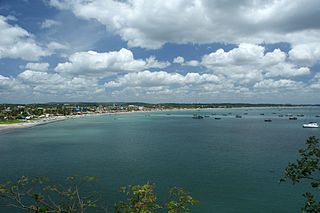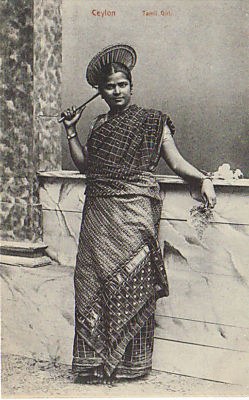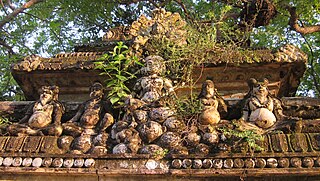Related Research Articles

Trincomalee, historically known as Gokanna and Gokarna, is the administrative headquarters of the Trincomalee District and major resort port city of Eastern Province, Sri Lanka. Located on the east coast of the island overlooking the Trincomalee Harbour, Trincomalee has been one of the main centres of Sri Lankan Tamil speaking culture on the island for nearly a millennium. With a population of 99,135, the city is built on a peninsula of the same name, which divides its inner and outer harbours. It is home to the famous Koneswaram temple from where it developed and earned its historic Tamil name Thirukonamalai. The town is home to other historical monuments such as the Bhadrakali Amman Temple, Trincomalee, the Trincomalee Hindu Cultural Hall and, opened in 1897, the Trincomalee Hindu College. Trincomalee is also the site of the Trincomalee railway station and an ancient ferry service to Jaffna and the south side of the harbour at Muttur.

Eelam is the native Tamil name for the South Asian island now known as Sri Lanka. Eelam is also the Tamil name for the spurge, toddy and gold.
Eelattu Poothanthevanar was one of the earliest known classical Ceylon Tamil poets from the Sangam period. He hailed from the ancient international port of Manthai in Ceylon, the ruins of which are in present-day Mannar District, Sri Lanka. His poems were included in the Tamil language anthologies of the Sangam literature compiled in Tamilakam before 250 CE. Writing in the city of Madurai, he praises the valour of the contemporaneous King Pasum Poon Pandyan, who, as per the Narkudi Velalar Varalaru, reigned from 275 to 240 BCE. Seven of his poetic verses feature in the Akananuṟu, Natriṇai and Kurunthokai.

Koneswaram Temple of Trincomalee or Thirukonamalai Konesar Temple – The Temple of the Thousand Pillars and Dakshina-Then Kailasam is a classical-medieval Hindu temple complex in Trincomalee, a Hindu religious pilgrimage centre in Eastern Province, Sri Lanka. The most sacred of the Pancha Ishwarams of Sri Lanka, it was built significantly during the ancient period on top of Konesar Malai, a promontory overlooking Trincomalee District, Gokarna bay and the Indian Ocean. The monument contains its main shrine to Shiva in the form Kona-Ishvara, shortened to Konesar.

The Jaffna kingdom, also known as Kingdom of Aryachakravarti, was a historical kingdom of what today is northern Sri Lanka. It came into existence around the town of Jaffna on the Jaffna peninsula and was traditionally thought to have been established after the invasion of Kalinga Magha from Kalinga in India. Established as a powerful force in the north, northeast and west of the island, it eventually became a tribute-paying feudatory of the Pandyan Empire in modern South India in 1258, gaining independence when the last Pandyan ruler of Madurai was defeated and expelled in 1323 by Malik Kafur, the army general of the Delhi Sultanate. For a brief period in the early to mid-14th century it was an ascendant power in the island of Sri Lanka, to which all regional kingdoms accepted subordination. However, the kingdom was overpowered by the rival Kotte kingdom around 1450 when it was invaded by Prince Sapumal under the orders of Parakramabahu VI.

The Arya Chakravarti dynasty were kings of the Jaffna Kingdom in Sri Lanka. The earliest Sri Lankan sources, between 1277 and 1283, mention a military leader of this name as a minister in the services of the Pandyan Empire; he raided the western Sri Lankan coast and took the politically significant relic of the Buddha's tooth from the Sinhalese capital city of Yapahuwa. Political and military leaders of the same family name left a number of inscriptions in the modern-day Tamil Nadu state, with dates ranging from 1272 to 1305, during the late Pandyan Empire. According to contemporary native literature, such as Cekaracecekaramalai, the family also claimed lineage from the Tamil Brahmins of the prominent Hindu pilgrimage temple of Rameswaram in the modern Ramanathapuram District of India. They ruled the Jaffna kingdom from the 13th until the 17th century, when the last of the dynasty, Cankili II, was ousted by the Portuguese.

Sri Lankan Tamils, also known as Ceylon Tamils or Eelam Tamils, are Tamils native to the South Asian island state of Sri Lanka. Today, they constitute a majority in the Northern Province, form the plurality in the Eastern Province and are in the minority throughout the rest of the country. 70% of Sri Lankan Tamils in Sri Lanka live in the Northern and Eastern provinces.

Arumuka Navalar was a Sri Lankan Shaivite Tamil language scholar and a religious reformer who was central in reviving native Hindu Tamil traditions in Sri Lanka and India.
Ketheeswaram temple is an ancient Hindu temple in Mannar, Northern Province, Sri Lanka. Overlooking the ancient Tamil port towns of Manthai and Kudiramalai, the temple has lain in ruins, been restored, renovated and enlarged by various royals and devotees throughout its history. Thirukketheeswaram is one of the Pancha Ishwarams dedicated to the Hindu deity Shiva and is venerated by Shaivas throughout the continent. Throughout its history, the temple has been administered and frequented by Sri Lankan Hindu Tamils. Its famous tank, the Palavi tank, is of ancient antiquity and was restored from the ruins. Thirukketheeswaram is one of the 275 Paadal Petra Sthalams of Shiva glorified in the poems of the Tevaram.

Keerimalai Naguleswaram temple, historically known also as the Thirutambaleswaram Kovil of Keerimalai, is a famous Hindu temple in Keerimalai, located north of Jaffna, Northern Province, Sri Lanka in the suburb of Kankesanthurai. One of the oldest shrines of the region, it is the northernmost of the island's Pancha Ishwarams of Siva, venerated by Sri Lankan Tamil Hindus around the world from classical antiquity. Hindus believe its adjacent water tank, the Keerimalai Springs, to have curative properties, which irrigation studies attribute to high mineral content sourced from underground.

The Sri Lankan Tamil dialects or Ceylon Tamil or commonly in Tamil language Eelam Tamil are a group of Tamil dialects used in Sri Lanka by its native Tamil speakers that are distinct from the Tamil dialects spoken in Tamil Nadu. These dialects are more conservative than the dialects spoken in India, and preserve features of Old and Medieval Tamil which have been lost in their Indian counterparts. In spite of this, both Sri Lankan and Indian Tamil dialects retain a degree of mutual intelligibility.

Nallur is an affluent suburb in Jaffna, Sri Lanka. It is located 3 km south from Jaffna city centre. Nallur is most famous for Nallur Kandaswamy temple, one of Sri Lanka's most sacred place of pilgrimage for Sri Lankan Hindus. Nallur is also famous for being the historical capital of the old Jaffna Kingdom and birthplace of renowned philosopher and theologian, Arumuka Navalar.
Yalpana Vaipava Malai is a book written by a Tamil poet named Mayil Vaakanaar in 1736. This book contains historical facts of the early Tamil city of Jaffna. The book may have been written around 1736, during the Governorship of Jan Maccara, the then Dutch Governor of Jaffna. It was translated from Tamil by C. Brito, and was first published in 1879. The work is looked upon as one of great authority among the Tamils of Jaffna.

Chunnakam Kumaraswamy Pulavar was a well-known Sri Lankan Tamil scholar and poet from Maylani village in Chunnakam township in Jaffna peninsula in the British-held Ceylon now known as Sri Lanka. He lived from 1854 to 1922. He along with other activists were instrumental in the revival of native traditions in Sri Lanka that had been long dormant during the previous 400 years of colonial rule by various European powers.
Sri Lankan Vellalar is a caste in Sri Lanka, predominantly found in the Jaffna peninsula and adjacent Vanni region, who comprise about half of the Sri Lankan Tamil population. They were traditionally involved in agriculture, but also included merchants, landowners and temple patrons. They also form part of the Sri Lankan Tamil diaspora.
Jeyaveera Cinkaiariyan was the Aryacakravarti king of the Jaffna Kingdom in modern-day northern Sri Lanka, who had a military confrontation with a southern chief known as Alagukonar al. According to traditional sources, Alagkkonara defeated Jeyaveera's naval and land forces and assumed royal power in the southern Gampola Kingdom. Later, King Harihara II's brother Yuvaraja Virupanna invaded Sri Lanka from Karnataka, defeated Alagkkonara and established a pillar of victory there.
Bhuvanekabahu VI of Kotte, also known as Sapumal Kumaraya or Yudistra Darma Dorai and Chempaka Perumal, was an adopted son of Parakramabahu VI. His principal achievement was the conquest of Jaffna Kingdom, a historical kingdom of what today is northern Sri Lanka, in 1447 or 1450. Although he was victorious and ruled, he was unable to prevent Kanakasooriya Cinkaiariyan and his two son's return from Madurai with mercenaries to wrest the Jaffna Kingdom from Kotte's over lordship. Bhuvanaikabahu was apparently summoned south after the demise of his adopted father. He then ruled for 17 years. According to Rajavaliya, he killed the grandson of Parakrama Bahu VI, namely Vira Parakrama Bahu or Jaya Bahu.
Kudiramalai is a cape and ancient port town on the west coast of Sri Lanka.
When to date the start of the history of the Jaffna kingdom is debated among historians.
The Pancha Ishwarams are five coastal ancient kovils (temples) built in dedication to the Hindu supreme being Ishwara in the form of the god Shiva, located along the circumference of Sri Lanka.
References
- 1 2 Knuth, Rebecca (2006). Destroying a Symbol: Checkered History of Sri Lanka's Jaffna Public Library (PDF). USA: University of Hawaii.
- 1 2 3 4 "50 years of Sri Lankan Tamil literature". Karthigesu Sivathamby. Retrieved 25 March 2008.
- ↑ Stokke, K.; Ryntveit, A.K. (2000). "The Struggle for Tamil Eelam in Sri Lanka". Growth and Change: A Journal of Urban and Regional Policy. 31 (2): 285–304. doi:10.1111/0017-4815.00129.
- ↑ Sri Lanka - Literature Encarta article reads: "The earliest known Sri Lankan Tamil poet was Eelattu Poothanthevanar, whose poems were included in the Tamil cankam (Sangam) poetry anthologies compiled in southern India before 250 AD.". Archived 2009-10-31.
- ↑ Ampikaipākan̲, Caṅkarappiḷḷai; Ambikaipakan, S. (1 January 1981). Eelanadu and the Tamil Sangams: Paper Presented by S. Ambikaipakan at the Fifth International Conference Seminar of Tamil Studies, Madurai.
- 1 2 Coddrington, H., Ceylon Coins and Currency, p.74
- 1 2 3 4 5 Gunasingam, M Sri Lankan Tamil Nationalism, p.64-65
- ↑ Nadarajan, V History of Ceylon Tamils, p.80-84
- ↑ Arumugam, S (1980). "Some ancient Hindu temples of Sri Lanka" (2 ed.). University of California: 37. OCLC 8305376.
{{cite journal}}: Cite journal requires|journal=(help) - ↑ S. Vithiananthan (1980). Nān̲kāvatu An̲aittulakat Tamil̲ārāycci Makānāṭṭu nikal̲ccikaḷ, Yāl̲ppāṇam, Can̲avari, 1974, Volume 2. p. 170
- ↑ "Tamils command respect in Sri Lankan cinema". JBR. Archived from the original on 2 December 2007. Retrieved 25 March 2008.